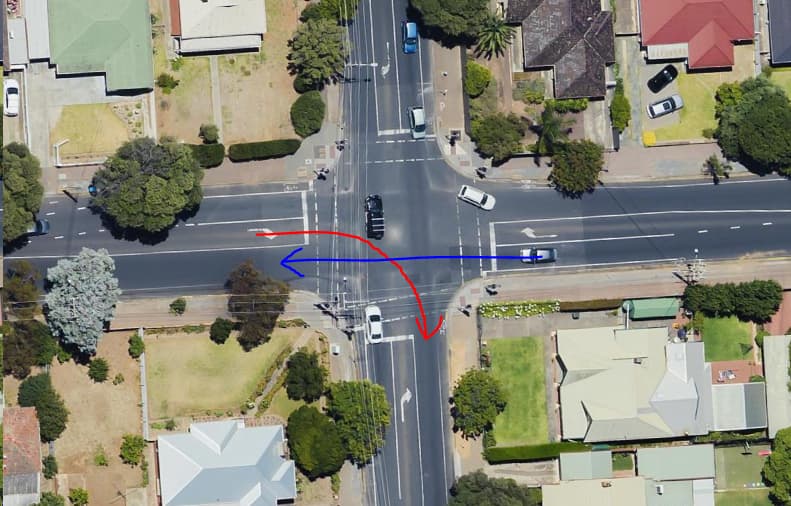Hi All,
My question is regarding how the iRAP model considers right turns (left turns in countries that drive on the right) at signalised intersections, and hence how these should be coded. There are essentially two ways to deal with right turns at signalised intersections: 1) Control right turns (red movement in below image) so that they are not allowed when opposing through movement is given a green signal (blue movement in below image), or 2) allow what we call “filter right turn” movements that allow the right turning driver to select a gap in the opposing traffic flow when the opposing through movement is given a green signal. In South Australia (where I am from), at intersections that allow filter right turns, these account for (on average) half of all fatal and serious injury crashes associated with intersection movements. Hence, considering whether filter right turns are allowed or not has a major impact on safety outcomes.
Does the iRAP model consider that filter right turns can be allowed or not when coding the intersection type as a signalised intersection, or is this differentiation not made? And (more importantly) can the banning or allowance of filter right turns be coded into iRAP?
Cheers, Chris.
1 Like
Hi Chris,
I have just seen this topic and you most likely have a solution already but I thought I’d give you my thoughts. I’ve had similar issues before with coding intersections. The iRAP coding doesn’t allow that amount granularity when it comes to coding intersections, but you could adjust the coding to achieve a closer fit. For instance, in your scenario if you know the turn volumes then you can code the intersection as 4-leg (unsignalised) intersection with the intersecting road volumes matching the turning volumes as opposed to the total side-road traffic volume. This approach works if the turning volumes are a high proportion of the overall traffic volumes, if not this approach can lead to a lower Star Rating Score. With low turning volumes you may need to assess both movements separately and combined their Intersection scores. Once you have this combined score you can adjust the original coding to match this SRS. The severity score does not change between signalised and unsignalised intersection types, so you need to adjust the road attributes that affect likelihood (Intersection type, Intersection quality, Grade, Street lighting, Skid resistance / grip, Sight distance, Intersection channelisation, Speed management / traffic calming). This may require you to use a higher volume or code the ‘intersection quality’ as poor and/or code it without street lighting. It does take a bit of extra effort but in my view, it gives a better representation of the risk level. It will be important to record this approach in the comments section with a more detailed explanation in the assessment report.
